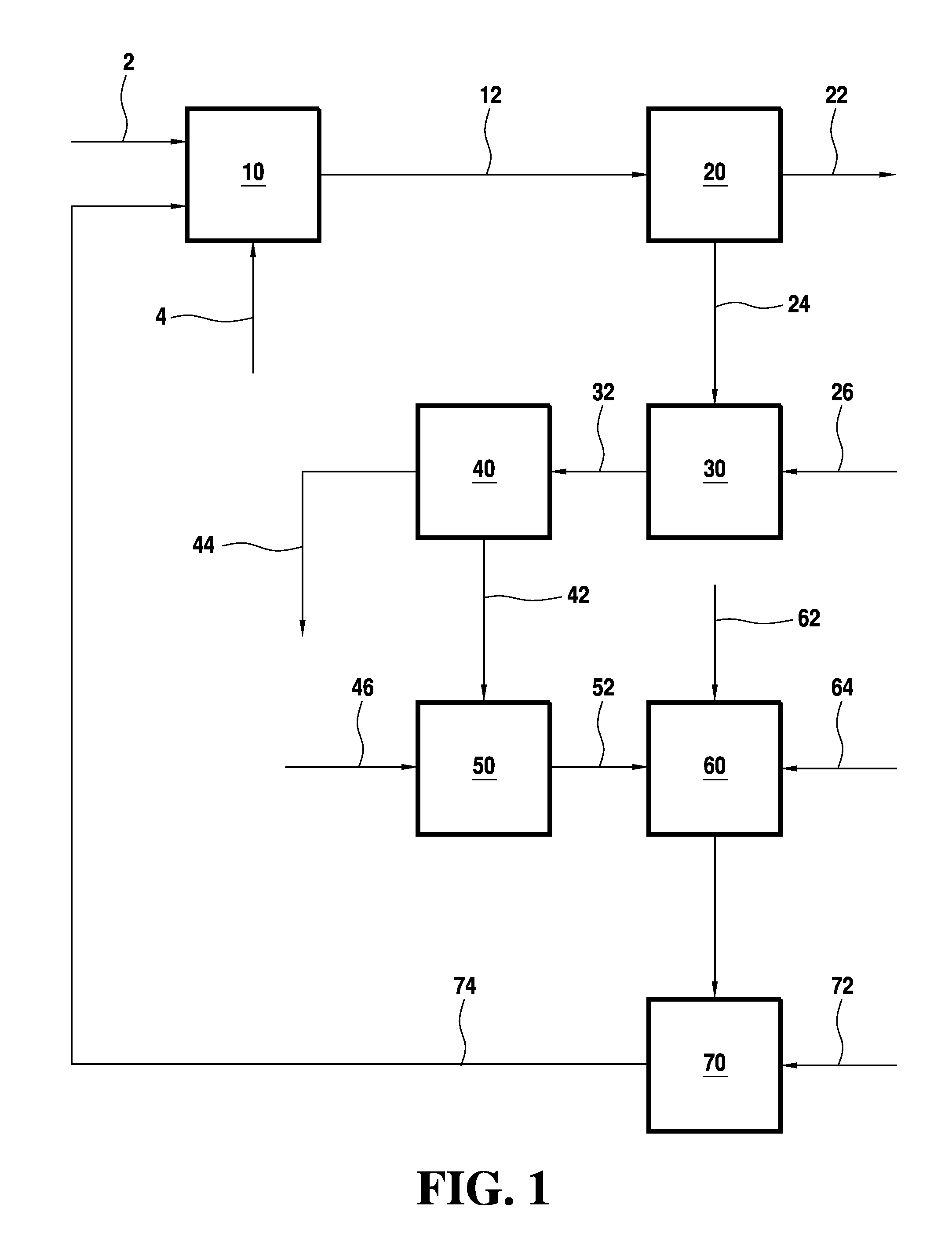Integrated process for producing polyvinyl alcohol or a copolymer thereof and ethanol
- Summary
- Abstract
- Description
- Claims
- Application Information
AI Technical Summary
Benefits of technology
Problems solved by technology
Method used
Image
Examples
example 1
[0085]A distillation was conducted using streams from a PVOH process. In the laboratory, a 40 tray Oldershaw column was employed. A mother liquor stream containing 0.24 wt % solids was fed about midway on the column, while an aqueous methanol stream containing 0.13 wt % solids was fed to the column about one third from the base. In the atmospheric distillation the overhead and the base temperatures were 68° C. and 100° C., respectively. The mother liquor feed rate was 13.7 g / min and the aqueous methanol feed rate was 11.5 g / min. The reflux ratio was maintained at about 0.23. No foaming or major fouling problems in the reboiler were observed during the distillation. Dark brown / black staining or fouling was observed from around tray 15 to the base. However, this minor fouling did not plug the small tray holes or downcomers of the Oldershaw column. The trays above the mother liquor feed were clean.
[0086]The analysis of the feed, overhead methanol / methyl acetate product, and the wastewa...
example 2
Prophetic
[0088]This Example describes hydrogenolysis of methyl acetate as reported in paragraph [0064] of U.S. Patent Publication No. 2009 / 0326080. Methyl acetate is maintained as a liquid at 20° C., is pumped at a pressure from 10 to 50 atm, through a heat exchanger that vaporizes it completely at a temperature from 150° C. to 225° C. Preheated hydrogen at the same temperature range is added to the vapors as they exit from the heat exchanger. The molar ratio H2 to methyl acetate is from 5 to 10. The hot mixture is blown through a catalytic bed including a CuO / copper chromite, a CuO / ZnO / Al2O3, or a CuO / ZnO / activated carbon catalyst and an inert solid which acts as a diluent of the catalyst. The CuO is reduced to Cu by adding a mixture of H2 and N2 prior to adding any acetate. The CuO is thus reduced to Cu, the active form in the hydrogenolysis reaction. The reduction is carried out until no water is produced. The exothermicity of the reduction of the CuO is controlled by keeping the...
example 3
[0089]This Example also describes hydrogenolysis of methyl acetate. Six experiments were conducted in a Rotoberty® continuous stirred-tank reactor (CSTR). The same charge of 40 mL of a copper-zinc oxide on alumina catalyst, i.e. MegaMax 700® (Süd Chemie), was used for all six experiments. The first four experiments were performed at ˜360-375 psig, and the last two were at a higher pressure of 625 psig. At 360 psig, two reactions were tested at 250° C. followed by two at 275° C.; one temperature of 250° C. was tested at 625 psig. For all six experiments, the methyl acetate LHSV alternated between 0.85 hr−1 and 1.25 hr−1, and the H2 to methyl acetate ratio was kept constant at approximately 14:1 H2 to methyl acetate mole ratio.
[0090]The reaction conditions and results for the six methyl acetate experiments are provided in Table 2. A summary of the product composition for experiment 2 is provided in Table 3.
[0091]In Table 2, calculations are made for methyl acetate conversion, selectiv...
PUM
| Property | Measurement | Unit |
|---|---|---|
| Volume | aaaaa | aaaaa |
| Mass | aaaaa | aaaaa |
| Mass | aaaaa | aaaaa |
Abstract
Description
Claims
Application Information
 Login to View More
Login to View More - R&D
- Intellectual Property
- Life Sciences
- Materials
- Tech Scout
- Unparalleled Data Quality
- Higher Quality Content
- 60% Fewer Hallucinations
Browse by: Latest US Patents, China's latest patents, Technical Efficacy Thesaurus, Application Domain, Technology Topic, Popular Technical Reports.
© 2025 PatSnap. All rights reserved.Legal|Privacy policy|Modern Slavery Act Transparency Statement|Sitemap|About US| Contact US: help@patsnap.com



